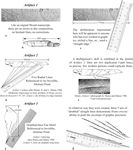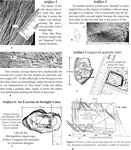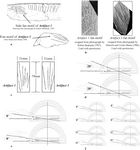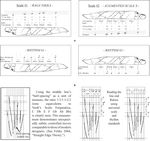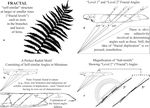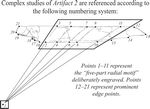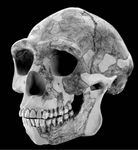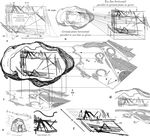“You show pretty unambiguously that those engravings
[which are 400,000 years old] are in no sense archaic.”
- International authority in the history of art and philosophy, 2006
“Archaeologists will try every trick in the book to reject
your interpretation of the engravings. It is entirely unacceptable to them that
they were completely wrong about the cognitive abilities of these people… you do
have science on your side... a proposition that is utterly falsifiable. Everyone
can repeat your experiment, and the engravings are fixed in time and space. If
your calculations are correct… the archaeologists will be stumped.”
- Renowned international authority, 2007, approximately 5 months after Graphics & Phi were presented
“[Your Bilzingsleben work] goes way beyond…theory of
phosphene/entoptic/doodles and way beyond any prior interpretation of the
‘savage mind’ of Homo erectus.”
- International authority on Paleolithic art 17 months after presentation
The
Graphics of Bilzingsleben was a "requested" paper with rigorous geometric
studies challenging the modern science notion that Homo erectus was an ape-man. Although it resulted in passionate and ongoing accolades such as those quoted on the full-text html
page, The Graphics of Bilzingsleben
was ultimately relegated to an
obscure miscellanea volume 'five years' after its presentation. This
was due to
the misconduct of competitive researchers and editors in several
science organizations and universities beginning within one week of the
Congress. The
story is part of increasing examples of misconduct in science which has been aggressively promoting to the public a
false impression of Paleolithic peoples. Many other examples related to Paleolithic sites other than Bilzingsleben have been published in Pleistocene Coalition News (PCN). The censorship story of The Graphics of Bilzingsleben as
well as use of the author's submitted materials to alter the writings
of competitive researchers with privileged access to the materials can be read in detail
in a series of nine articles in Pleistocene Coalition News
(Issues #12-20). One can also go directly to the Series (Parts
1-9) in quick html form which includes very sharp enlargable figures
starting with Part 1, Proof of Straight Edge Use By Homo erectus.
Organizations
such as Retraction Watch have also begun to cover the problem of
misconduct in the sciences in general. The journal, Science, as part of its own response to the problem, recently echoed a paper published in Proceedings of the National Academy of Science (PNAS) that "misconduct" rather than "mistakes" is the cause of most retractions of scientific papers.
Retractions due to misconduct including such as fabrication of data or
plagiarism are on the rise in science while rigorous original papers
such as those discussed in PCN experience similar fates to The Graphics of Bilzingsleben.
This particular paper was produced in response to a request made to the author to expound on recently published original work, e.g., straight edge use by H. erectus and scientific proofs of the earliest duplicated symbol. The session chair making the request was already quite
familiar with the rigor and integrity of the prior work, which is what prompted the request, and which included The Impact of Fossils on the Development of Visual Representation (blocked by Current Anthropology while an author who had prior borrowed from the paper without citation was published therein shortly afterwards) and Musings on the Palaeolithic Fan Motif (also a requested paper).
Positive
response to the
presentation was
immediate and passioned and lasted for the next seven months. All
subsequent comments followed exactly as the
first comment at the Congress: "an absolutely thrilling presentation."
It is clear in retrospect that plans for censorship of the paper and
its Part 2, Phi in the Acheulian
(geometric proofs of mathematical ratio in Lower Paleolithic bone engravings, microlithic tools,
etc.), began at that moment for political rather than
scientific reasons for beginning within one week of the Congress two
falsified reports were published in which both papers were deleted. The
first was by a cataloguer of the Chair and was published in The European Archaeologist
as a response to the session in which the two back-to-back papers
(totalling 40 minutes in the middle of the session) were deleted from the
presenter-by-presenter account of the session. This created immediate problems with the
presenter's sponsors having made it appear to the sponsors that the two
papers were not even presented.
The second effort a few weeks later was for both Co-Chairs of the session to block
the Part 2 paper, Phi in the Acheulian, claiming that it was "highly problematic" and would
damage the author's reputation were it to be published. However, simultaneously, one of the Co-Chair/Editors, who had not written on the topic of geometry before, quickly
produced their own version of an Acheulian Phi paper, submitting it
to a French journal without any reference to
the original work. This was done while the original author's paper, including full references
and supplementary material, were still in hand due to priviledged acces as an editor of the
session.
The original author
wrote several complaints to the French journal which refused to retract the
paper (a similar occurance happened with another author's paper presented in a related session at the
XV UISPP Congress). After the original
author insisted on the Part 2 paper's publication (promised in advance
by the UISPP with the author being a paying presenter at the Congress)
the censorship
effort was then switched over by the Co-Chair/Editors to the "Part 1"
paper, Graphics,
which wound up being relegated to an obscure volume four years "after"
the Part 2 paper was published. This was with the Session Chair's false claim that there was no time
to publish it having put an arbitrarily fast deadline on all
presenters in the Session. The second falsified report was by the Session Chair
making it appear in a second confirmation as though neither
paper had been presented at the Congress. As anyone would understand, falsehoods like this in published form manipulated
the author's 11 sponsors into believing that the sponsored presenter did not fulfill the obligation. No presenter at a Conference, especially a requested presenter, should have to deal with such
misconduct in the science community. By this time the author's only recourse for the sake of sponsors and public record was to produce a webpage, The Graphics of Bilzingsleben, posting original responses to the paper and beginning to tell the story of misconduct in anthropology so
that sponsors and other readers could see that the papers were indeed
presented and to what response.
To demonstrate how the misconduct affects both researchers and those who trust the process of science, in the politics of
the XV UISPP Congress the
paper quickly went from being called "absolutely outstanding and
stunning...breathtaking...a
landmark
contribution," as spoken by the Session Chair, to the
same Chair stating in a cc message to international colleagues that the author
had been
told all along that the paper had, "no scientific merit." If one cannot reconcile these two one knows something of what the
five-year battle for publication was like. Similar to
the other Chair's uncredited use of the Part 2
materials (Phi in the Acheulian), within two months of the presentation, the Chair published a
quick paper making extraordinary over-the-top claims for bone engravings discovered 10
kilometers
from Bilzingsleben. Again, this was done with all submitted Graphics of Bilzingsleben
materials in hand and without any citation to
explain where the sudden bolstered claim and confidence in Neanderthal
representational drawing came from. This fact is notable for the
reason that the Chair was a prior long-published detractor of
representation in Neanderthal or Homo erectus engravings. The artifacts had
been mentioned before, but this
time, fresh from the UISPP Congress and the proofs presented in the Graphics of Bilzingsleben,
the makers of the artifacts suddenly went from being barely conscious ape-men to artistic genuises without
attributing a single word on where the sudden change of interpretation had come from. It was also done
without showing any geometric or technical reasoning for the claims which were made.
Afterwards, the agendas of the Session Chair/Editors extended next to the XV UISPP General Editor, as well as to the Journal of Human Evolution and an anonymous censorship board ultimately resulting in the paper's five-year publication block. The author (a requested presenter) was treated as a troublemaker
by the General Editor (an associate of the Chair)
with The Graphics of Bilzingsleben being called a "polemic."
The story as presented above
was an impetus behind formation of the
Pleistocene Coalition in 2009 joining forces with many other
researchers, PhDs and professors of similar experience, to fight
against suppression and censorship in anthropology. Similar
blockades involve organizations such as the American Association for
the Advancement of Science (AAAS) and
the National Center for Science Education (NCSE) and many other organizations which
are outspoken promoters of the
evolutionary paradigm. Evidence that conflicts with this paradigm or evidence such as in The Graphics of Bilzingsleben which actually falsifies the paradigm is
blocked from the public. The result is a public which, through trusting
well-known institutions without looking into the evidence for themselves, winds up being easily misled
regarding Paleolithic peoples. The subject of understanding Paleolithic peoples is
absolutely critical in modern
times because proclemations from the science community have great
control over what
individual persons as well as ethnic groups or nations believe
about their identity. This has direct repurcussions on the rest of
modern human culture. Science institutions and science
leaders need to be
held accountable for falsifying the reality of what evidence of early
peoples is
actually out there allowing the public to see evidence from all sides
whether or not it conflicts with the agendas of powerful institutions
or ethnic groups. "Normal sciences" do not mislead the
public through suppression of evidence. This is a trait of evolutionary
anthropology, evolutionary psychology, and evolutionary biology. It is
not difficult to see what these three have in common. So, The Graphics of Bilzingsleben
was censored for two different reasons, 1.) the personal agendas of
competitive researchers, and 2.) the powerful and censorship-dependent
agenda of evolutionary sciences for which the paper offers no support
whatsoever but challenges them at their very core.
The above information is regarding:
Feliks,
J. 2011. The Graphics of Bilzingsleben: Sophistication and subtlety in the mind of Homo erectus. In Oosterbeek, L. and C. Fidalgo (eds), Proceedings of the XV UISPP World Congress
(Lisbon, 2006), British Archaeological Reports International Series 2224, Oxford, pp. 71-91.
Return to The Graphics of Bilzingsleben full-text html
